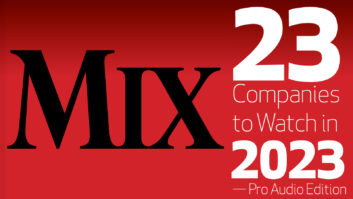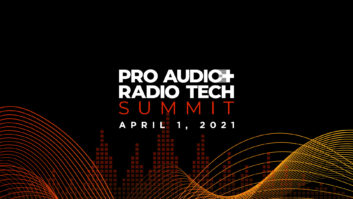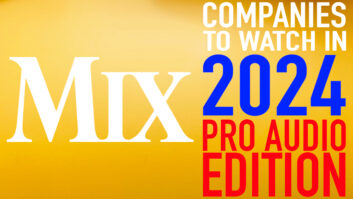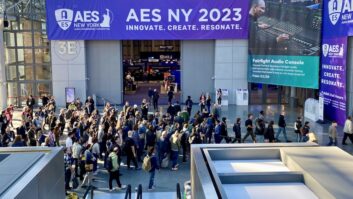When podcasting emerged in the early 2000s, the format often felt like a gawky kid brother to talk radio—a domain of programming with limited reach and even more limited appeal to mainstream listeners. Those days are gone. According to Edison Research, 64 percent of Americans have heard of podcasts, 44 percent—which is to say 124 million people—have listened to at least one, and 32 percent of Americans between the ages of 25 and 54 now listen to them every month.

An oft overlooked key to podcasting success is its sound quality, and the pro audio marketplace has moved to address the format’s needs as podcasting has taken off. “Personally, as a fan of many podcasts across several genres … the poor sound quality of some shows bothered me,” said Dan Hughley, market manager for Focusrite. “So much so that even though I liked the content of certain shows, I noticed I wasn’t listening to those shows where I experienced audio issues as often anymore, or I was only listening to them in smaller doses or when they had a guest I was especially interested in. This is what convinced me that more podcasters need to be concerned and educated about their audio quality production, and that excites me to address this market.” Focusrite has been doing just that. Hughley cites a number of podcasts that now use Focusrite interfaces, ranging from solo efforts that use the Scarlett 2i2 to in-studio productions that use gear from the top end of the Clarett USB line.

Part of podcasting’s appeal to content creators is its relatively low barrier to entry, but that also means that many who enter the field don’t come to it with an audio background. “While there are certainly audio experts in the field of podcasting, the majority of users are looking for a way to share their hobby, talents, advice and their story with a broader audience,” said Robb Blumenreder, manager of audio for video at Sennheiser. “Most people don’t have a high level of audio experience, so finding creative ways to bridge that knowledge gap is an important step toward getting them started. Content creation can be addictive when you hit your stride. We often see users wanting to upgrade sooner rather than later when they recognize that their voice is part of their brand.” Accordingly, Sennheiser has been bringing products like its MK 4 digital, HandMic digital, ClipMic digital and AMBEO Smart Headset to podcasters’ attention.
While podcasts often focus on storytelling, listening to new podcasts over time can inadvertently reveal another story: that of how their creators learn more about audio and find gear appropriate to their needs. Derek Badala, Synthax’s director of sales for the Americas, explained, “The podcast community struggles with a mix-minus setup when interviewing folks via Skype. If you see the videos and links online, there are all kinds of crazy solutions offered, usually with adapters, Y cables and just bad audio practices.” With those scenarios in mind, Synthax’s RME brand points to the Babyface Pro interface as a solution.

Still, parsing the pro audio world can be intimidating to new podcasters. Manufacturers including Audio-Technica have been reaching out to the community through user events at SXSW and PAX gaming culture festivals. Audio-Technica’s Gary Boss, marketing director, professional markets, noted, “We knew early on that many Audio-Technica mics were being selected as popular options for podcasting…. While professional podcasters will use very high-end studio products, the majority of users are not as tech savvy as studio engineers. The more we can help them select the appropriate mic, the better.” A-T now has four turnkey podcast/streamer packs with a mic, headphone and boom arm; the packs feature AT2035, AT2020, AT2020USB+ and AT2005USB microphones.

For many podcasters, the ability to record on a mobile device is a key factor, not only for portability but also for the simple fact that they already own a smartphone or tablet that can be tasked for production. Soren Pedersen, senior product specialist at Shure, said, “We noticed that more content creators are using their mobile devices to capture content on-the-go, [and] the need for digital microphones that allow them to capture professional sounding audio—anytime, anywhere—is also increasing.” As a result, Shure introduced the MOTIV line, which is aimed at emerging content creators, including in the fields of podcasting and YouTube video creation. “MOTIV was a chance to provide a solution for quicker, more agile content needs on devices like mobile phones and laptops,” said Pedersen.
Whether by introducing new lines of gear or demonstrating how longtime industry-standard equipment can be applied to podcasting, pro audio manufacturers are finding that the new content format ultimately sits comfortably in their wheelhouse. As a representative for TASCAM—which has seen podcasters turn to its DR-40 and DR-10X digital recorders—put it, “From a market perspective, we see no fundamental difference between podcasters and the recording musicians we have traditionally supported. In both cases, you are dealing with artists who are looking to communicate thoughts and emotion. The only real difference is that one primarily speaks, while the other plays and sings, but in the end, the technical needs are quite similar.”
ONLINE EXTRA • Podcast Gear at Work
What are some podcasts our readers can check out that use your gear?
Audio-Technica
“There are a number, but one your readers might find enjoyable (or may be currently following) is Working Class Audio. Matt is currently using the BP40 on this show.” —Gary Boss
Focusrite
“There are so many, but a few to check out include Pat Flynn’s Smart Passive Income; Amy Porterfield’s Marketing Made Easy; Julian Placino’s Pathways to Success; Daniel J. Lewis’ The Audacity to Podcast; and Lewis Howes’ School of Greatness and many more.” —Dan Hughley
RME/Synthax
“Jonathan from ChooseFi.com along with Dan Franks from Podcast Movement both use RME products.” —Derek Badala
Sennheiser
“We recently partnered with Stitcher — helping to outfit their content creation studios on both coasts of the U.S., and we have also been selected as their official headphone brand. Their app is a fantastic way to experience a wide variety of curated podcast content.” —Robb Blumenreder
Shure
“Marc Maron famously used the SM7B on his WTF podcast that spawned a television show of the same name, and it’s also the primary mic for the Joe Rogan Experience. Serial host Sarah Keonig uses our KSM32 condenser as does This American Life.” —Soren Pedersen
TASCAM
“In addition to the successful and educational TASCAM Talkback, there are a variety of popular podcasts being produced on TASCAM gear including the WDW Tiki Room Disney-focused podcast, the We Be Geeks pop culture podcast and many more.” —Erik Larsen






